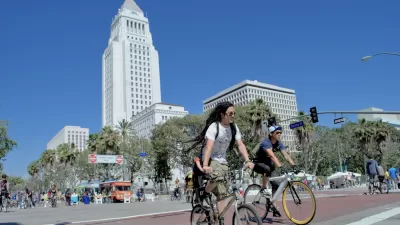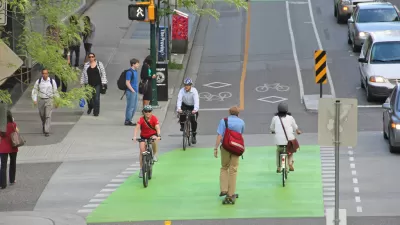A near-unanimous response to this week’s question on National Journal's Transportation Experts Blog was that we are far from being intermodal.
A near-unanimous response to this week's question on National Journal's Transportation Experts Blog was that we are far from being intermodal.
National Journal Transportation Experts Blog Weekly Summary
NOTE: Each week, some 80 invited "Beltway Insiders," including members of Congress, governors, state and local transportation officials, senior executives of trade associations, environmentalists and respected transportation professionals, debate current transportation issues on National Journal's Transportation Expert Blog. Pursuant to an agreement between Planetizen and the National Journal, weekly summaries of this dialogue will henceforth be posted on "Interchange." The summaries will be prepared by Ken Orski, a regular participant in the National Journal 's Transportation Blog and an occasional contributor to Planetizen's blog. Read more and see the full list of contributors at the National Journal Transportation Experts Blog.
According to Jeffrey Shane, former Undersecretary for Policy at U.S. Department of Transportation and currently partner of the Washington law firm of Hogan & Hartson, despite all the initiatives in the interest of intermodal institutions (e.g. establishment of a single federal Department of Transportation) and intermodal policies (e.g. creation of an Office of Intermodalism and a National Intermodal Transportation Commission), our federal transportation program remains stubbornly mode-specific. The federal funds are apportioned to each mode and each mode's users insist that their money be reserved for that mode- wholly predictable and entirely understandable, but arguably the very antithesis of an intermodal approach to transportation, says Shane. "My own view," writes Shane," is that we probably will never alter the current mode-centric structure of federal transportation programs." But that's no reason to despair, Shane continues. U.S. DOT can break down the modal barriers by identifying and supporting major multimodal projects of regional or national significance and reducing the programmatic impediments to their financing and delivery.
Strengthening intermodalism within USDOT is also a recommendation offered by Steve Van Beek, President of the Eno Transportation Foundation and former Director of Intermodalism at USDOT. There must be someone in the Office of the Secretary to act as an intermodal and multimodal advocate, Van Beek argues. His job should include ensuring that modal regulations and policies are not irrationally getting in the way of multimodal solutions (e.g. current rules restrict airports from using their revenue on airport access projects). Rich Sarles, Executive Director of NJ TRANSIT, is of the same opinion. "Congressional leadership and the Obama Administration would be wise to place intermodalism and multimodalism at the top of the policy and planning agenda," he writes. Moreover, a new funding category should be considered for projects that are multimodal and do not fit the standard modal mold.
Developing a national strategic transportation plan with an intermodal and multi-modal perspective must be one of the priorities of the next surface transportation reauthorization bill, writes Rep. John L. Mica (R-FL), Ranking Member of the House Committee on Transportation and Infrastructure. We must utilize the strengths of our various transportation modes in a way that makes the entire system stronger and more efficient. We must develop not just a better highway system or a better aviation system or a better rail system but a better transportation system, Mica contends.
If we are looking to promote a more integrated and intermodal system in the next surface transportation bill, the flexibility provided in the stimulus bill is a great model to follow, suggest Ed Hamberger, President of the Association of American Railroads and Geraldine Knatz, Executive Director of the Port of Los Angeles. The bill gave states the ability to spend their infrastructure investment dollars not just on highways and bridges but on rail projects, avaiation and port projects. National strategic investments in infrastructure must be based on a comprehensive intermodal plan that takes into account freight flows.

Maui's Vacation Rental Debate Turns Ugly
Verbal attacks, misinformation campaigns and fistfights plague a high-stakes debate to convert thousands of vacation rentals into long-term housing.

Planetizen Federal Action Tracker
A weekly monitor of how Trump’s orders and actions are impacting planners and planning in America.

In Urban Planning, AI Prompting Could be the New Design Thinking
Creativity has long been key to great urban design. What if we see AI as our new creative partner?

King County Supportive Housing Program Offers Hope for Unhoused Residents
The county is taking a ‘Housing First’ approach that prioritizes getting people into housing, then offering wraparound supportive services.

Researchers Use AI to Get Clearer Picture of US Housing
Analysts are using artificial intelligence to supercharge their research by allowing them to comb through data faster. Though these AI tools can be error prone, they save time and housing researchers are optimistic about the future.

Making Shared Micromobility More Inclusive
Cities and shared mobility system operators can do more to include people with disabilities in planning and operations, per a new report.
Urban Design for Planners 1: Software Tools
This six-course series explores essential urban design concepts using open source software and equips planners with the tools they need to participate fully in the urban design process.
Planning for Universal Design
Learn the tools for implementing Universal Design in planning regulations.
planning NEXT
Appalachian Highlands Housing Partners
Mpact (founded as Rail~Volution)
City of Camden Redevelopment Agency
City of Astoria
City of Portland
City of Laramie





























